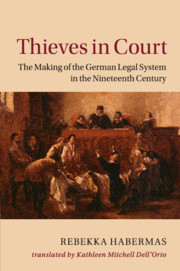Book contents
- Frontmatter
- Dedication
- Contents
- Acknowledgments
- Introduction: Questions Regarding Thieves, Reformers, Jurists, and Others
- PART I WHAT IS THEFT: QUESTIONS REGARDING THIEVES AND JURISTS – QUESTIONS REGARDING HONOR AND PROPERTY
- PART II HOW LAW IS MADE: EVIDENCE PRODUCTION
- 4 Techniques for Finding Truth – the Slow Production of the Modern State of Law
- 5 Techniques for Finding Truth and Other Types of Knowledge Formation: How Can a New Outlook Be Put into Practice?
- 6 Techniques for Finding Truth: How Do People Become Jurists and How Does Property Come into Being?
- PART III IN THE COURTROOM, OR WHAT IS LAW?
- Conclusion: The Making of the Modern Legal System – Thieves and Property
- Relevant Laws
- Bibliography
- Index
4 - Techniques for Finding Truth – the Slow Production of the Modern State of Law
from PART II - HOW LAW IS MADE: EVIDENCE PRODUCTION
Published online by Cambridge University Press: 18 November 2016
- Frontmatter
- Dedication
- Contents
- Acknowledgments
- Introduction: Questions Regarding Thieves, Reformers, Jurists, and Others
- PART I WHAT IS THEFT: QUESTIONS REGARDING THIEVES AND JURISTS – QUESTIONS REGARDING HONOR AND PROPERTY
- PART II HOW LAW IS MADE: EVIDENCE PRODUCTION
- 4 Techniques for Finding Truth – the Slow Production of the Modern State of Law
- 5 Techniques for Finding Truth and Other Types of Knowledge Formation: How Can a New Outlook Be Put into Practice?
- 6 Techniques for Finding Truth: How Do People Become Jurists and How Does Property Come into Being?
- PART III IN THE COURTROOM, OR WHAT IS LAW?
- Conclusion: The Making of the Modern Legal System – Thieves and Property
- Relevant Laws
- Bibliography
- Index
Summary
WHAT IS EVIDENCE?
The more important evidence became, the more unclear it was what exactly evidence actually was, when evidence was evidence and when it was only a false or even a bogus. Although the preliminary investigation concentrated increasingly on searching for evidence, only indirect indications can be found in the 1848 Code of Criminal Procedure regarding what is to be understood as “evidence.” Only a single paragraph referred explicitly to what was to be accomplished in the preliminary investigation. Article 157 of the 1848 Electoral Hessian Code of Criminal Procedure, stated that the “objective facts of the case” were to be ascertained, the “proof of the perpetrator's guilt” was to be provided, and “collection of the [information] on circumstances that were the basis for assigning the penalty were to be carried out.” There was not a word about how “collection” was to proceed. A Law on Criminal Procedure that took effect in Electoral Hesse in 1863 did not describe the task in any more detail. Likewise, in the 1877 German Code of Criminal Procedure scarcely a word was lost on the substance of the work to be performed in the preliminary investigation. Textbooks emphasized the “great importance … of the court preliminary investigation,” but its exact form and thus the definition of what evidence was remained obscure.
Furthermore, instead of clear definitions of evidence or perhaps even guidelines for evidence collection being issued, the few instructions usual until then for evaluating evidence were rescinded. In contrast to the inquisitorial process of the Early Modern Period – and this is a second important difference – the so-called free consideration of evidence now applied, that is, there were no clear rules that determined once and for all what evidence was substantive and what was not. The Constitutio Criminalis Carolina (1532) defined not only just two possible types of proof of guilt, but also clear rules on how various types of evidence were to be assessed. For example, it was specified there that the statement of a low-class person was less substantive than that of a higher-class person. Thus, an evidence hierarchy existed that was of course administered flexibly in individual cases but still did not provide eo ipso a great deal of room for interpretation.
- Type
- Chapter
- Information
- Thieves in CourtThe Making of the German Legal System in the Nineteenth Century, pp. 100 - 126Publisher: Cambridge University PressPrint publication year: 2016



